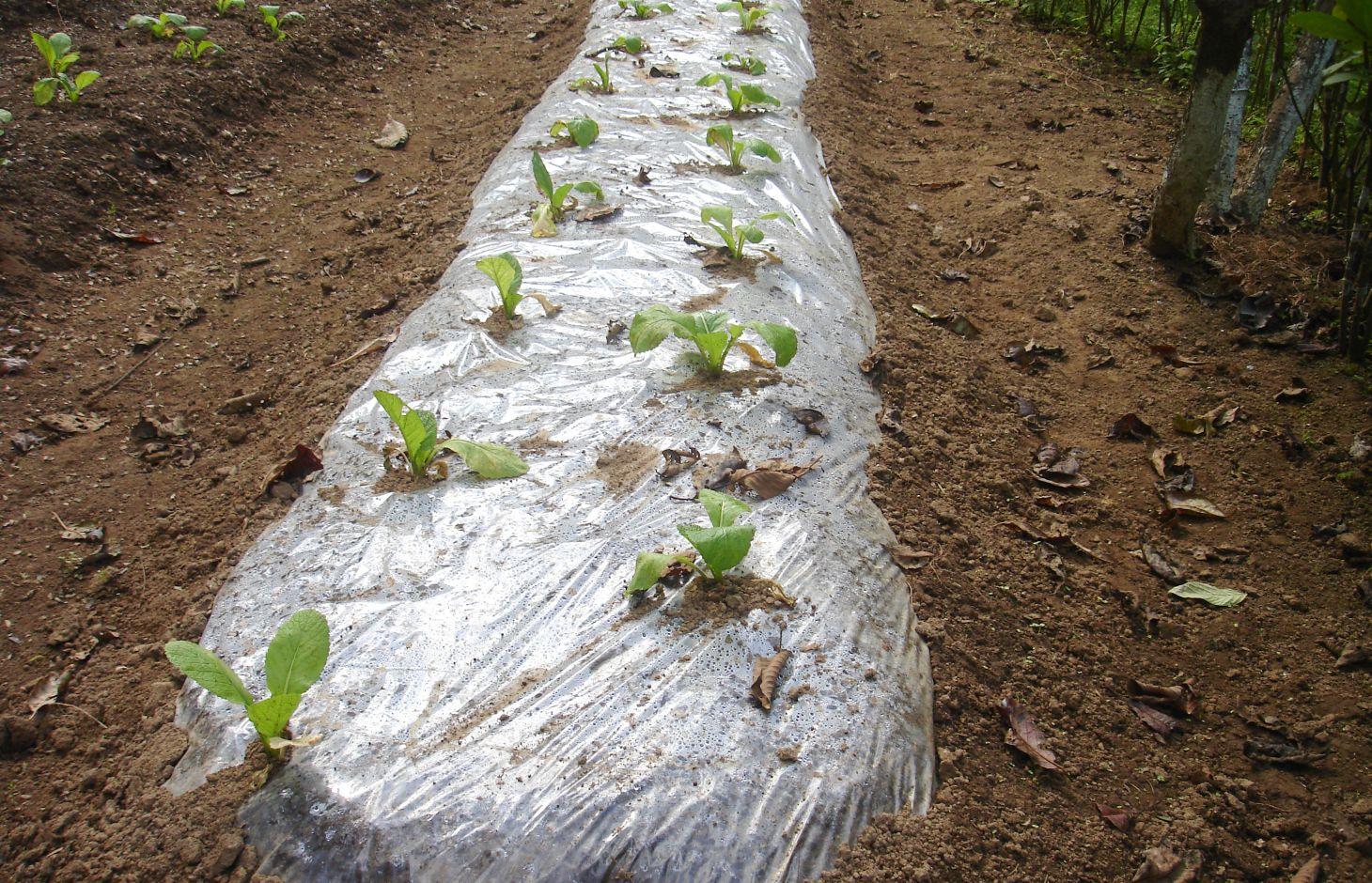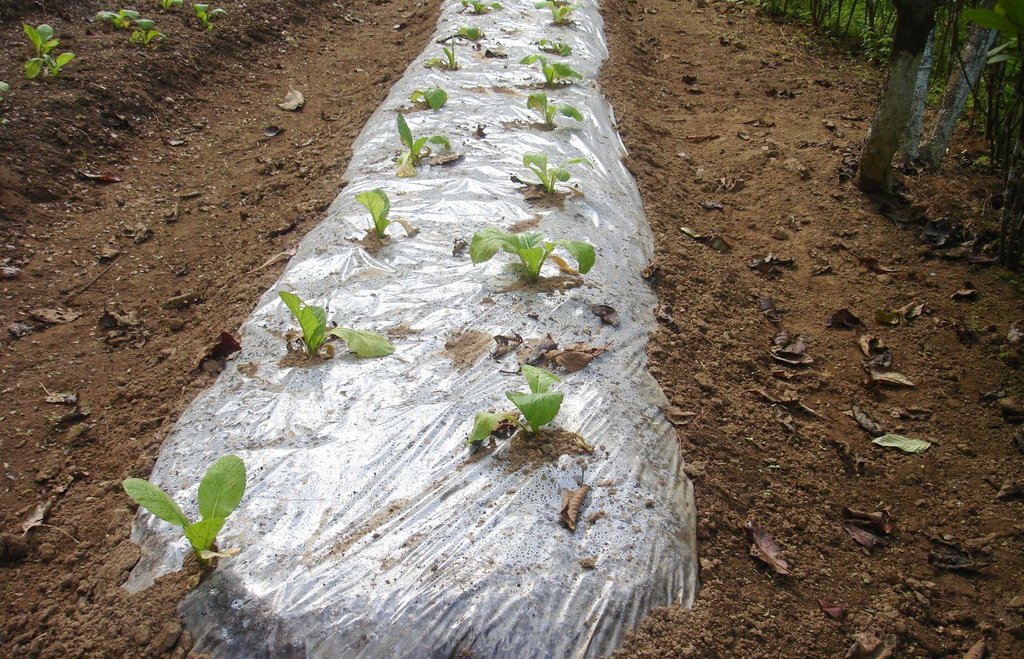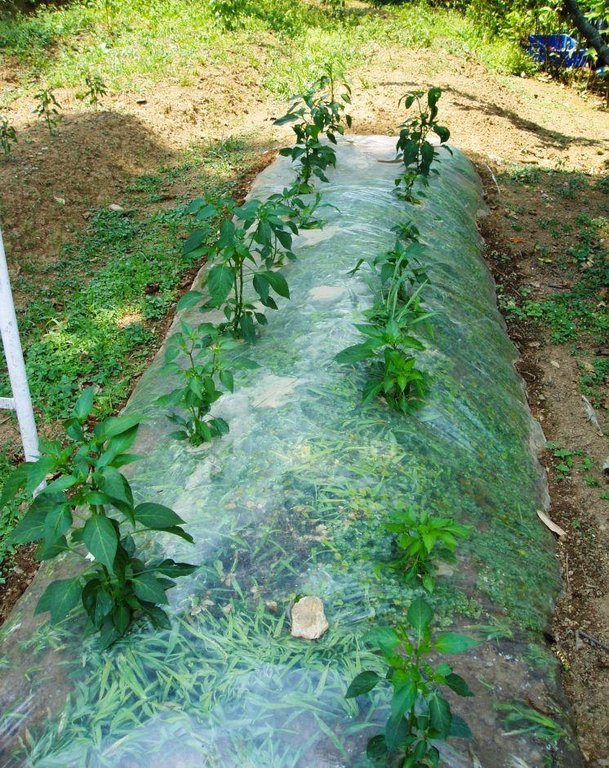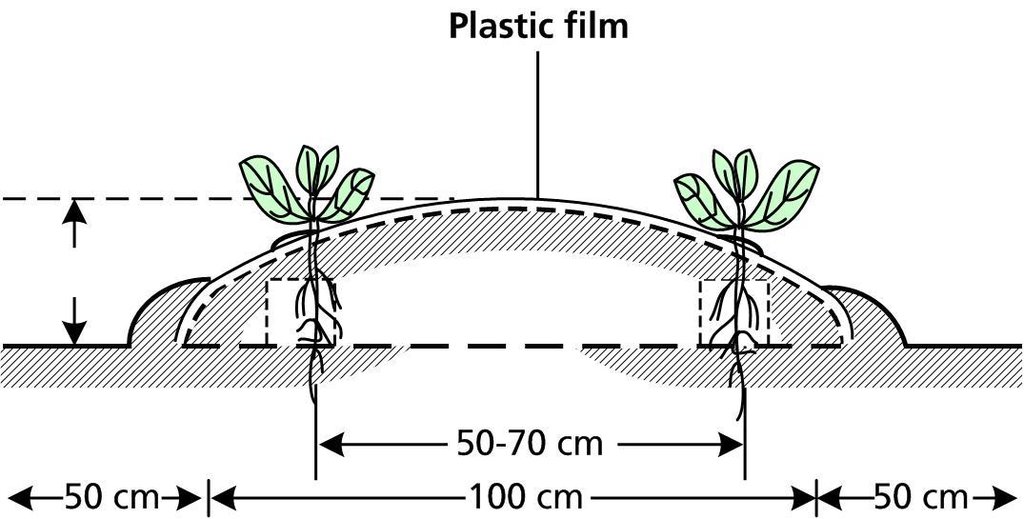Plastic film technology [النيبال]
- تاريخ الإنشاء:
- تحديث:
- جامع المعلومات: Shreedip Sigdel
- المحرر: –
- المُراجع: David Streiff
Plastic proyog gari kheti garne prabidhi (Main Contributor: Samden Sherpa, ICIMOD)
technologies_1687 - النيبال
عرض الأقسام
توسيع الكل طي الكل1. معلومات عامة
1.2 تفاصيل الاتصال بالأشخاص الرئيسيين لمصدر المعلومات والمؤسسات المشاركة في تقييم وتوثيق التقنية
متخصص في الإدارة المستدامة للأراضي:
Sherpa Samden Lama
+977 1 5003222
ssherpa@icimod.org
ICIMOD
P.O.Box 3226, Kathmandu, Nepal
النيبال
اسم المؤسسة (المؤسسات) التي سهلت توثيق/تقييم التقنية (إذا كان ذلك على صلة)
ICIMOD International Centre for Integrated Mountain Development (ICIMOD) - النيبال1.3 الشروط المتعلقة باستخدام البيانات الموثقة من خلال WOCAT
متى تم تجميع البيانات (ميدانيا)؟:
01/03/2013
يوافق جامع المعلومات والشخص (لاشخاص) الرئيسي لمصدر المعلومات على الشروط المتعلقة باستخدام البيانات الموثقة من خلال WOCAT:
نعم
2. وصف تقنيةالإدارة المستدامي للأراضي
2.1 وصف مختصر للتقنية
تعريف التقنية:
Plastic film technology, sometimes called plastic mulching, is an important breakthrough that can transform traditional agriculture into modern agriculture by helping to circumvent many of the limitations of temperature and moisture. Plastic film is used to cover the surface of the soil in order to increase the temperature, to retain moisture, and to promote the germination of seeds.
2.2 وصف تفصيلي للتقنية
الوصف:
Agricultural production by traditional methods is constrained by extremes in temperature and by extremes in the availability of water; freezing temperatures as well as droughts and waterlogging have long daunted farmers. When plastic film is used on the soil, the solar energy absorbed by the soil during the day is retained at night since the plastic film prevents water from evaporating. Higher night time temperatures and higher levels of moisture in the ground promote active micro-organisms, which diminish the need for fertilizer and improve the physical properties of the soil.
Purpose of the Technology: Plastic film can be used in one of two ways. In the first method, the plastic film is spread on ridges of soil, the plastic is perforated at regular intervals, and the seedlings are planted through these openings. In the other method, seeds are planted on the ridges as in the traditional method, and when the seedlings have grown to a reasonable size, the ridge is covered by a plastic film and holes are cut at the position of the seedlings to allow them to pass through the film. Depending on the condition of the film after the crops are harvested, the covered ridges can be used to grow another crop.
Establishment / maintenance activities and inputs: Experiments at ICIMOD show that the use of plastic film can, on average, double the crop yield as compared to traditional methods. Previous studies by Lu Rongsen (1994) showed that the plastic film method can increase chilli production by 74%, tomato production by 52%, and the production of garden peas by 31%.
2.3 صور التقنية
2.5 البلد/المنطقة/المواقع التي تم تنفيذ التقنية فيها والتي يغطيها هذا التقييم
البلد:
النيبال
مزيد من التفاصيل حول الموقع:
Lalitpur District
2.7 إدخال التقنية
حدد كيف تم إدخال التقنية:
- أثناء التجارب/الأبحاث
3. تصنيف تقنية الإدارة المستدامي للأراضي
3.1 الغرض الرئيسي ( الأغراض الرئيسية) للتقنية
- تحسين الإنتاج
3.2 نوع (أنواع) استخدام الأراضي الحالية حيث يتم تطبيق التقنية

الأراضي الزراعية
- زراعة سنوية
التعليقات:
Major land use problems (compiler’s opinion): Farmers have traditionally used mulching to retain moisture in the soil and to help plants withstand ground frost. Mulching is useful but has many limitations. Recently, plastic film technology has been successfully introduced to help retain moisture in the soil and to promote seed germination. Since moisture is retained, the temperature of the soil does not drop as low as it would otherwise; this accelerates the growth and the development of both the roots and the whole plant, resulting in good crops and high yields.
Forest products and services: fuelwood
Other forest products and services: Fodder
Constraints of Scrubland
3.3 مزيد من المعلومات حول استخدام الأراضي
عدد مواسم الزراعة في السنة:
- 2
3.4 مجموعةالإدارة المستدامة للأراضي التي تنتمي إليها هذه التقنية
- تحسين الغطاء الأرضي/النباتي
3.5 انتشار التقنية
حدد انتشار التقنية:
- منتشرة بالتساوي على مساحة
التعليقات:
It was done in demonstration plote
3.6 التدابير التقنية في مجال إلادارة المستدامة للأراضي

التدابير الإدارية
- M7: أخرى
3.7 الأنواع الرئيسية من تدهور الأراضي التي تناولتها التقنية

تدهور المياه
- (Ha): التجفيف
3.8 منع أو حد أو عكس تدهور الأراضي
تحديد هدف التقنية فيما يتعلق بتدهور الأراضي:
- الحد من تدهور الأراضي
4. المواصفات الفنية، وأنشطة التنفيذ، والمدخلات، والتكاليف
4.1 الرسم الفني للتقنية
4.2 المواصفات الفنية/شروحات الرسم الفني
The diagram shows a cross-section of a ridge planted using plastic film technology. The plants grow through holes punched in the plastic. The plastic helps to retain moisture in the soil and, in so doing, also helps to increase the soil temperature. Weeds trapped below the plastic are inhibited from interfering with the crop.
The ridges (or beds) are typically 20 m long, 1 m wide and spaced 1 m apart (for access); they are usually 10–20 cm high. The distances shown in the diagram are averages for crops such as chillies where the row-to-row distance is 50–70 cm and the plant-to plant distance is 40–50 cm. These distances vary according to the crop.
Technical knowledge required for land users: moderate
Main technical functions: Increase the temperature of the soil and promote seed germination and emergence, Retain soil moisture and reduce soil erosion
Secondary technical functions: Accelerates the growth and development of roots and plants in areas where the temperature is low dur, Hastens maturation of crops and increase yield and promote good quality crop
Change of land use practices / intensity level
4.3 معلومات عامة بخصوص حساب المدخلات والتكاليف
حدد كيفية احتساب التكاليف والمدخلات:
- حسب مساحة تنفيذ التقنية
الإشارة إلى حجم ووحدة المساحة:
ha
حدد العملة المستخدمة لحساب التكاليف:
- دولار أمريكي
4.4 أنشطة التأسيس
| النشاط | نوع التدبير | التوقيت | |
|---|---|---|---|
| 1. | The plot of land to be planted is prepared by first fertilizing it with a mixture of soil, compost, and/or farmyard manure. The soil is gathered into parallel ridges, typically 20 m long, 1 m wide, and 10–20 cm high; the distance between two ridges is usually 40–50 cm. For many crops the seedlings are spaced 50–70 cm apart. | إدارية | |
| 2. | Method #1 Plastic film (approx. thickness 0.014–0.003 mm) is used to cover the ridges and anchored into the ground. Round holes are punched in the film at regular intervals. Some soil is excavated through the holes and the seedlings are planted through the holes and thoroughly watered. The holes in the plastic are sealed using soil. | إدارية | |
| 3. | Method#2 Seeds are sown on the ridges and seedlings are allowed to develop. The ridge is covered in plastic film and the film is anchored. Holes are punched into the plastic at the position of the seedlings so that they pass through. | إدارية | |
| 4. | For either method, when the crops are harvested all residue should be removed. Depending on local conditions and on whether the plastic film is still viable, the plastic covered ridges can be reused to grow another crop without replacing the film. | إدارية |
4.5 التكاليف والمدخلات اللازمة للتأسيس
| تحديد المدخلات | الوحدة | الكمية | التكاليف لكل وحدة | إجمالي التكاليف لكل مدخل | % من التكاليف التي يتحملها مستخدمو الأراضي | |
|---|---|---|---|---|---|---|
| العمالة | Preparing land plot | persons/day/ha | 80,0 | 3,875 | 310,0 | |
| معدات | Spade, secateurs | ha | 1,0 | 10,0 | 10,0 | |
| معدات | Plastic film | kg/ha | 48,0 | 1,0 | 48,0 | |
| المواد النباتية | Seedlings | ha | 1,0 | 250,0 | 250,0 | |
| إجمالي تكاليف إنشاء التقنية | 618,0 | |||||
4.6 الصيانة/الأنشطة المتكررة
| النشاط | نوع التدبير | التوقيت/الوتيرة | |
|---|---|---|---|
| 1. | Provide crop support such as staking and removal of excess leaves as required | إدارية |
4.7 التكاليف والمدخلات اللازمة للصيانة/للأنشطة المتكررة (سنويًا)
| تحديد المدخلات | الوحدة | الكمية | التكاليف لكل وحدة | إجمالي التكاليف لكل مدخل | % من التكاليف التي يتحملها مستخدمو الأراضي | |
|---|---|---|---|---|---|---|
| العمالة | Support the crops | persons/day/ha | 30,0 | 3,6668 | 110,0 | |
| معدات | Bamboo poles | ha | 1,0 | 20,0 | 20,0 | |
| إجمالي تكاليف صيانة التقنية | 130,0 | |||||
4.8 أهم العوامل المؤثرة على التكاليف
قدم وصفا لأهم العوامل التي تؤثر على التكاليف:
This was a demonstration project conducted by ICIMOD.
All costs and amounts are rough estimates by the technicians and authors.
5. البيئة الطبيعية والبشرية
5.1 المناخ
هطول الأمطار السنوي
- < 250 مم
- 251- 500 ملم
- 501 - 750ملم
- 1,000-751 ملم
- 1,500-1,100 ملم
- 2,000-1,500 ملم
- 3,000-2,001 ملم
- 4,000-3,100 ملم
- > 4000 ملم
المنطقة المناخية الزراعية
- شبه رطبة
Thermal climate class: temperate
5.2 طوبوغرافيا
متوسط الانحدارات:
- مسطح (0-2%)
- بسيط (3-5%)
- معتدل (6-10%)
- متدحرج (11-15%)
- تلال (16-30%)
- شديدة الانحدار(31-60%)
- فائقة الانحدار (>60%)
التضاريس:
- هضاب/سهول
- أثلام مرتفعة
- المنحدرات الجبلية
- منحدرات التلال
- منحدرات في السفوح
- قاع الوادي
المنطقة الارتفاعية:
- 100-0 متر فوق سطح البحر
- 500-101 متر فوق سطح البحر
- 1,000-501 متر فوق سطح البحر
- 1,500-1,001 متر فوق سطح البحر
- 2,000-1,501 متر فوق سطح البحر
- 2,500-2,100 متر فوق سطح البحر
- 3,000-2,501 متر فوق سطح البحر
- 4,000-3,001 متر فوق سطح البحر
- > 4000 متر فوق سطح البحر
5.3 التربة
متوسط عمق التربة:
- ضحل جدًا (0-20 سم)
- ضحلة (21-50 سم)
- متوسطة العمق (51-80 سم)
- عميقة (81-120 سم)
- عميقة جدًا (> 120 سم)
قوام التربة (التربة السطحية):
- متوسط ( طميي، سلتي)
المواد العضوية في التربة السطحية:
- عالية (>3%)
إذا كان متاحًا، قم بإرفاق وصف كامل للتربة أو تحديد المعلومات المتوفرة، على سبيل المثال نوع التربة، الرقم الهيدروجيني/ درجة حموضة التربة، قدرة التبادل الكاتيوني، النيتروجين، الملوحة وما إلى ذلك.
Soil fertility is medium
Soil drainage / infiltration is medium
Soil water storage capacity is medium
5.4 توافر المياه ونوعيتها
منسوب المياه الجوفية:
< 5 م
توافر المياه السطحية:
جيد
تعليقات ومواصفات أخرى بشأن نوعية المياه وكميتها:
Water quality (untreated): Also for agricultural use (irrigation)
5.5 التنوع البيولوجي
تنوع الأنواع:
- مرتفع
5.6 خصائص مستخدمي الأراضي الذين يطبقون التقنية
التوجه السوقي لنظام الإنتاج:
- مختلط (كفاف/ تجاري)
الدخل من خارج المزرعة:
- >50% من إجمالي الدخل
المستوى النسبي للثروة:
- ضعيف
أفراداً أو مجموعات:
- موظف (شركة، حكومة)
مستوى المكننة:
- عمل يدوي
- الجر الحيواني
اذكر الخصائص الأخرى ذات الصلة لمستخدمي الأراضي:
Population density: < 10 persons/km2
5.7 متوسط مساحة الأرض المملوكة أو المستأجرة من قبل مستخدمي الأراضي الذين يطبقون التقنية
- < 0.5 هكتارا
- 0.5 - 1 هكتار
- 1 -2 هكتار
- 2 - 5 هكتار
- 5 - 15 هكتار
- 15 - 50 هكتار
- 50 - 100هكتار
- 500-100 هكتار
- 1,000-500 هكتار
- 10,000-1,000 هكتار
- > 10,000 هكتار
5.8 ملكية الأراضي، وحقوق استخدام الأراضي، وحقوق استخدام المياه
ملكية الارض:
- دولة
حقوق استخدام الأراضي:
- مجتمعي (منظم)
- فردي
حقوق استخدام المياه:
- فردي
5.9 الوصول إلى الخدمات والبنية التحتية
الطرق والنقل:
- ضعيف
- معتدل
- جيد
Labour:
- ضعيف
- معتدل
- جيد
6. الآثار والتصريحات الختامية
6.1 الآثار التي أظهرتها التقنية في الموقع
الآثار الاجتماعية والاقتصادية
الإنتاج
إنتاج المحاصيل
التعليقات/ حدد:
in areas with a long winter season
الدخل والتكاليف
دخل المزرعة
التعليقات/ حدد:
less time is spent weeding
الآثار الاجتماعية والثقافية
المعرفة بالإدارة المستدامة للأراضي/تدهور الأراضي
livelihood and human well-being
التعليقات/ حدد:
improved crops and higher yields benefit the entire community because more food is available and the harvest brings in cash income.
الآثار الايكولوجية
التربة
رطوبة التربة
الآثار الايكولوجية الأخرى
soil erosion and nutrient loss
soil temperature
weeds are controlled
discarded plastic
6.2 الآثار التي أظهرتها التقنية خارج الموقع
الفيضان في اتجاه مجرى النهر
التعليقات/ حدد:
Downstream farmers benefit because soil is conserved and runoff is reduced
6.3 تعرض التقنية وحساسيتها لتغير المناخ التدريجي والظواهر المتطرفة/الكوارث المرتبطة بالمناخ (كما يراها مستخدمو الأراضي)
العواقب الأخرى المتعلقة بالمناخ
العواقب الأخرى المتعلقة بالمناخ
| كيف تتعامل التقنية مع ذلك؟ | |
|---|---|
| long spell of low temperature, frost and snowfall | جيدا |
6.4 تحليل التكلفة والعائد
كيف يمكن مقارنة العوائد نسبة لتكاليف الإنشاء (من وجهة نظر مستخدمي الأراضي)؟
عوائد قصيرة الأجل:
إيجابي
عوائد طويلة الأجل:
ايجابي جدا
كيف تتم مقارنة العوائدمع كلفة الصيانة/التكاليف المتكررة (من وجهة نظر مستخدمي الأراضي)؟
عوائد قصيرة الأجل:
ايجابي جدا
عوائد طويلة الأجل:
ايجابي جدا
6.5 اعتماد التقنية
- حالات فردية/تجريبية
من بين جميع الذين تبنوا التقنية، كم عدد الذين فعلوا ذلك بشكل تلقائي، أي دون تلقي أي حوافز مادية/مدفوعات؟:
- 10-0%
التعليقات:
There is a moderate trend towards spontaneous adoption of the Technology
Comments on adoption trend: Acceptance/adoption:
This demonstration of plastic film technology was used mainly to show that it is viable both in the mid-hills and at higher elevations where temperatures can be very low during the winter season. Plastic film technology can be used to cultivate high-value horticultural crops such as vegetables, strawberries, and melons. In China, it has been successfully used to cultivate more than 80 species (Lu Rongsen 1994).
Driver for adoption:
Improved income for farmers and less time is spent weeding. Greater awareness among farmers is being spread through participatory research and development in rural areas.
Constraints
Plastic film is not always available in rural areas
6.7 نقاط القوة / المزايا / الفرص التي توفرها التقنية
| نقاط القوة/ المزايا/ الفرص من وجهة نظر جامع المعلومات أو غيره من الاشخاص الرئيسيين لمصدر المعلومات |
|---|
|
Plastic film technology can increase the yield of some crops by as much as 100% as compared to conventional farming. How can they be sustained / enhanced? Since this technology is still relatively new, it will be necessary to continue sharing experiences and to promote awareness. |
|
Plastic film technology can be used to grow crops in hilly areas where the long winter season is usually too cold to support crops. How can they be sustained / enhanced? Need to create greater awareness of the benefits of using plastic film technology in mountain areas |
6.8 نقاط ضعف / مساوىء / مخاطر التقنية وسبل التغلب عليها
| نقاط الضعف/ المساوىء/ المخاطر من وجهة نظر جامع المعلومات أو غيره من الاشخاص الرئيسيين لمصدر المعلومات | كيف يمكن التغلب عليها؟ |
|---|---|
| As farmers begin to use plastic film technology more plastic is being discarded in rural areas. | Plastic film needs to be retrieved and recycled. In China it has been shown that this is possible. |
| Discarded plastic film can pollute agricultural lands | Farmers need to be made aware of hazards and encouraged to form networks for collection and recycling the used plastic. |
7. المراجع والروابط
7.2 المراجع للمنشورات المتاحة
العنوان، المؤلف، السنة، النظام القياسي الدولي لترقيم الكتب ISBN:
The application of plastic film technology in China: Plastic film technology data collected and analyzed in ICIMOD D&T Centre, Godavari. Kathmandu, Nepal: ICIMOD, Rongsen, L (1994)
الروابط والوحدات المواضيعية
توسيع الكل طي الكلالروابط
لا يوجد روابط
الوحدات المواضيعية
لا يوجد وحدات مواضيعية





